Coin Values Moving with Precious Metals: Up-Dated 12/8/2025: Gold $4212 | Silver $58.12
Value of V Nickels
Premium value of V nickels is found in a few key dates and mintmark combinations. Also, all of these Liberty nickels are prized by collectors in lightly circulated condition. Following a step by step processes identifies the correct value listing of your coin on the chart.
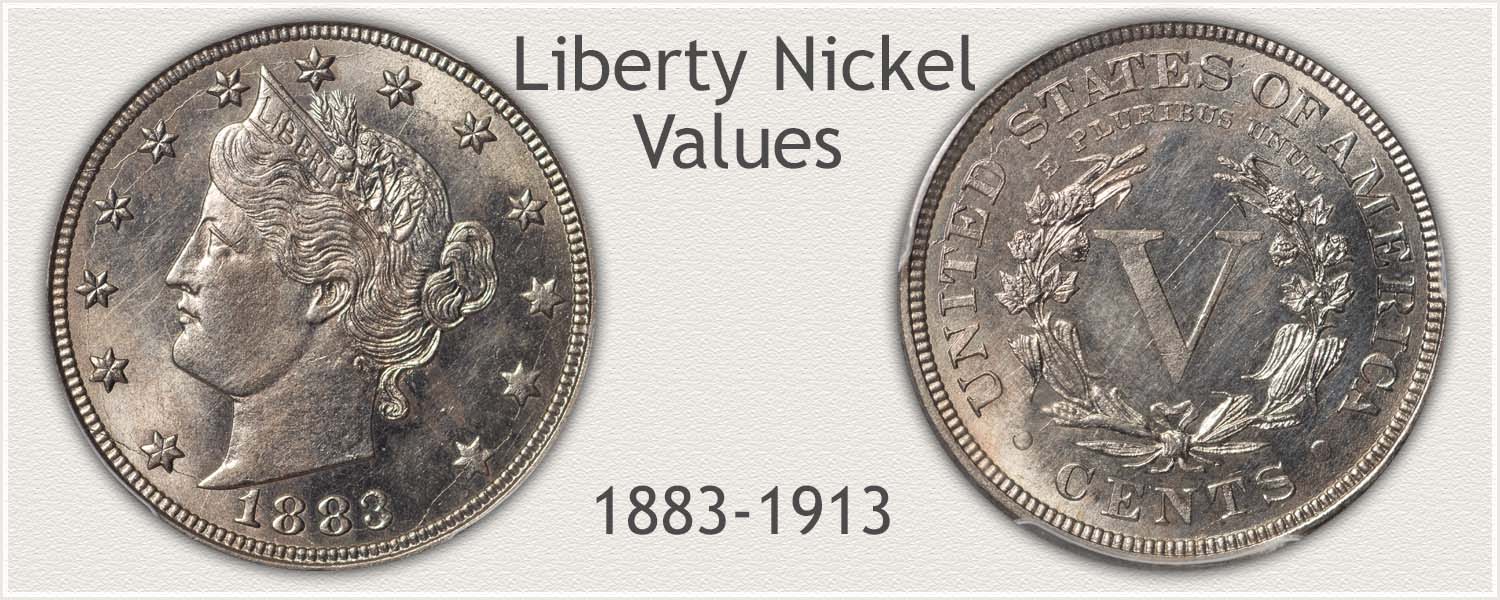
Steps Leading to Value:
- Step 1: Date, Mintmark and Variety - Images and descriptions identify date, mintmark, and design variety.
- Step 2: Grading Condition - Judging condition narrows value range of Liberty nickels. Video, images, and descriptions are used to compare your coin.
- Step 3: Special Qualities - Often quality of minting determines eye appeal and desirability of many coins.
The following chart clearly shows the value of V nickels is both "date" and "condition" driven. Of the two; your chances of finding a rare date are not as good as finding a better grade coin. Step 2 covers judging condition to find the grade range on the chart.
| Value of V Nickels 1883-1913 | ||||
|---|---|---|---|---|
| Condition of Coin | ||||
| Date | Good | Fine | Extremely Fine | Mint State |
| Value of V Nickels Updated | 2026 | |||
| 1883 No Cents | $5.42 | $7.15 | $12 | $40 |
| 1883 W-Cents | $15 | $30 | $62 | $106 |
| 1884 | $15 | $31 | $63 | $208 |
| 1885 | $293 | $634 | $1,051 | RARE |
| 1886 | $113 | $247 | $446 | $1,230 |
| 1887 | $11 | $24 | $57 | $154 |
| 1888 | $21 | $49 | $133 | $235 |
| 1889 | $11 | $25 | $60 | $198 |
| 1890 | $7.58 | $21 | $61 | $219 |
| 1891 | $5.42 | $16 | $52 | $119 |
| 1892 | $5.20 | $20 | $48 | $135 |
| 1893 | $4.98 | $19 | $53 | $169 |
| 1894 | $12 | $68 | $178 | $395 |
| 1895 | $4.55 | $19 | $54 | $153 |
| 1896 | $7 | $30 | $84 | $211 |
| 1897 | $3.03 | $9.32 | $38 | $140 |
| 1898 | $2.60 | $10 | $39 | $132 |
| 1899 | $2.06 | $5.85 | $28 | $99 |
| 1900 | $1.95 | $6.07 | $32 | $84 |
| 1901 | $1.50 | $5.74 | $25 | $85 |
| 1902 | $1.50 | $4.68 | $24 | $83 |
| 1903 | $1.43 | $4.77 | $26 | $83 |
| 1904 | $1.44 | $4.98 | $24 | $86 |
| 1905 | $1.38 | $4.01 | $25 | $87 |
| 1906 | $1.40 | $4.77 | $24 | $82 |
| 1907 | $1.45 | $4.55 | $27 | $91 |
| 1908 | $1.42 | $4.66 | $24 | $85 |
| 1909 | $1.43 | $4.77 | $24 | $83 |
| 1910 | $1.38 | $4.55 | $24 | $79 |
| 1911 | $1.40 | $4.55 | $23 | $77 |
| 1912 | $1.38 | $4.55 | $24 | $78 |
| 1912 D | $2.06 | $8.88 | $87 | $195 |
| 1912 S | $87 | $163 | RARE | RARE |
The above are wholesale Liberty nickel values. Computed from dealer's price lists with various mark-up factors figured in. They reflect closely the value you would expect to receive when selling.
Variations in value do occur subject to subtle grading points, collector demands and dealer needs.
Step 1: | Date Plus Variety and Mintmarks are Identified
Liberty nickels were first minted in 1883, notable for both adding Liberty's portrait to the obverse and the large "V" Roman numeral 5 as a reverse design
Variety 1 Liberty Nickel: 1883 Without Cents Reverse

Minted along-side the Shield nickel in 1883; the new "V" nickel featured many changes to the nickel design.
Variety I: 1883 only, a profile of Liberty is surrounded by thirteen stars on the obverse. The short-lived reverse is the "V" Roman numeral 5 within a wreath. Importantly for identification of this variety, the motto "E Pluribus Unum" was placed at the bottom along the lower rim.
Proving unsatisfactory for identifying the denomination; Variety I "without cents" was redesigned. Struck only in 1883, these are a popular and necessary addition to collecting the series.
Variety 2 Liberty Nickel: 1883 to 1913 With Cents Reverse

1883 second variety is the same obverse with Liberty's portrait surrounded by stars. Redesigning the reverse placed the motto "E Pluribus Unum" above the wreath. Adding "Cents" below the wreath was important to clarify the denomination. This new reverse continued until the end of the series in 1913.
The "with cents" reverse nickels of 1883 are sought by collectors as a first of design year. Demand is steady creating solid value.
Denver Mint Variety Liberty Nickel
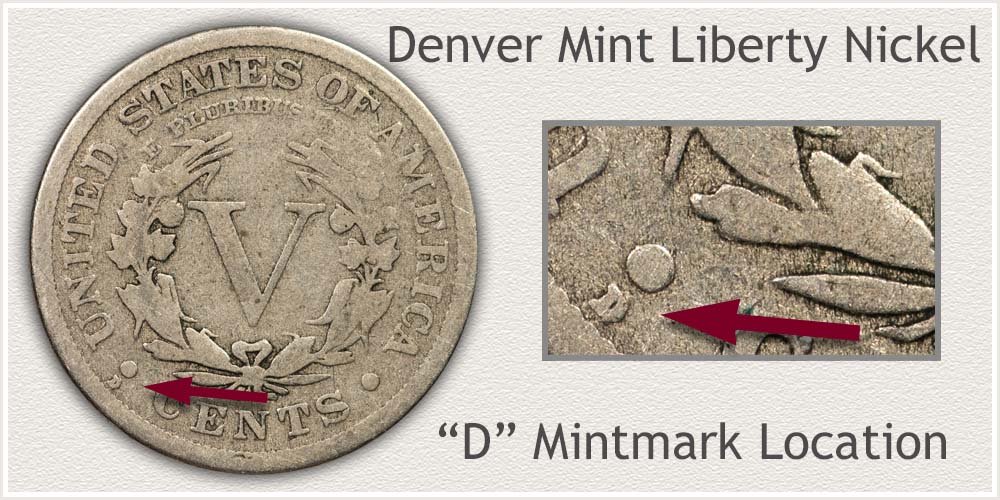
The Denver mint struck Liberty nickels in 1912, the only year. 1912 was also the last of circulation strike issues of the series. These are in favor with collectors; the "last of issue" status and a small comparative number minted: 8,747,000 pieces. Higher condition examples are sought by collectors with above average values.
Location of the "D" mintmark is on the reverse along the rim in front of "Cents".
San Francisco Mint Variety Liberty Nickel

San Francisco mint also contributed to production of Liberty nickels. In 1912 only, they struck a total of 238,000 pieces and created one of the series key issues. The small amount of coinage became the lowest number of any variety circulation strike Liberty nickel. These trade strongly in value just behind the 1885 and 1886 keys.
Look to the reverse of 1912 nickels to find the "S" mintmark. Along the rim above the "C" in Cents a small "S" denotes the San Francisco mint. The letter is small, no larger than the design dot above and needs magnification to confirm.
Philadelphia Mint Variety Liberty Nickel

Philadelphia mint struck coins every year of the Liberty nickel series. They did not mark their production in any way, no mint mark for the Philadelphia mint coins.
Of importance to mint variety is the 1912 date only. With the addition of two branch mints striking coins this year, accurate identity of mint determines value. On the reverse, along the rim and just above "C" in Cents is a small dot. If the areas between the dot and rim is clear the coin was minted in Philadelphia.
Step 2: | Grading Condition an Important Step to Value
A quick scan of your coin begins the grading process. Focus attention on the head band in Liberty's hair above her forehead. As more letters in the legend "LIBERTY" show, the better the condition. No letters, Good condition, 3 letters VG condition, a full "LIBERTY" and your nickel is in Fine or better condition. Difference in value of V nickels from one date - and now "grade" becomes clear.
The Value of V Nickels is Narrowed by Grading Condition

Mint State Grade: Liberty Nickel

Obverse: Features Identifying Mint State Grade: Mint state coins are special because of no wear to the surface. These coins are as minted. Key areas are judged to identify a coin meets the standard of no wear.
Fine lines of hair are above Liberty's forehead and noted as remaining with original surfaces with no smoothing, a result of wear.
Grains of wheat above the coronet are still rounded in profile, no flatness is visible. Cotton leaves and bolls are without any signs of flattening and smoothing.
Liberty's cheek is very prone to showing signs of handlining and wear. Look closely at the texture of metal, consistent grain to the surface indicated no wear. Neckline just above the date is also free of wear on the example mint state nickel.

Reverse: Features Identifying Mint State Grade: A very finely detailed wreath of corn and cotton has many areas high in relief. Areas along edges of leaves and grains quickly show any signs of wear.
Grains within the corn left of the bow must remain without any flatness.
Inspect the edges of all leaves, a slightly raised area is noted along the edge without any flatness. Minute detail is seen within the cotton and corn.
The central "V" remains with a texture similar to the field of the coin just below. Wear causes the "V" to appear smooth in comparison. Original mint luster gives the "V" and fields a soft glow when under a light, indicating mint state condition.
Extremely Fine Grade: Liberty Nickel

Obverse: Features Identifying Extremely Fine Grade: Wear is light across the surface, a small amount of flatness is evident. Localized and disconnected flattening helps define the Extremely Fine grade.
Lettering in coronet is bold and complete. All letters must show and the coronet is defined by a bold upper and lower line inside the edge.
Above the coronet, wheat grains are visible, two cotton bolls, and leaves are all bold and distinct. Any flattening to these elements is minor without blending of one into another.
Forehead is completely separated from hairline. Strands of hair remain visible above forehead and towards Liberty's ear.
Liberty's cheek shows a small flatness under her eye.

Reverse: Features Identifying Extremely Fine Grade: Overall a well-defined wreath remains, defining the Extremely Fine grade.
Key to the grade is small details are bold. Just right of the bow, an ear of corn remains with visible kernels.
High points are just beginning to flatten on the leaves of cotton further up the right side of the wreath. Each leaf is defined and separated.
Central knot of the bow is well raised above the stems on either side.
Design of cotton bolls remains; a clear distinction is bold and showing the upper cotton fluff and leaves just below. Sharp fine lines remain throughout the majority of wreath.
Fine Grade: Liberty Nickel
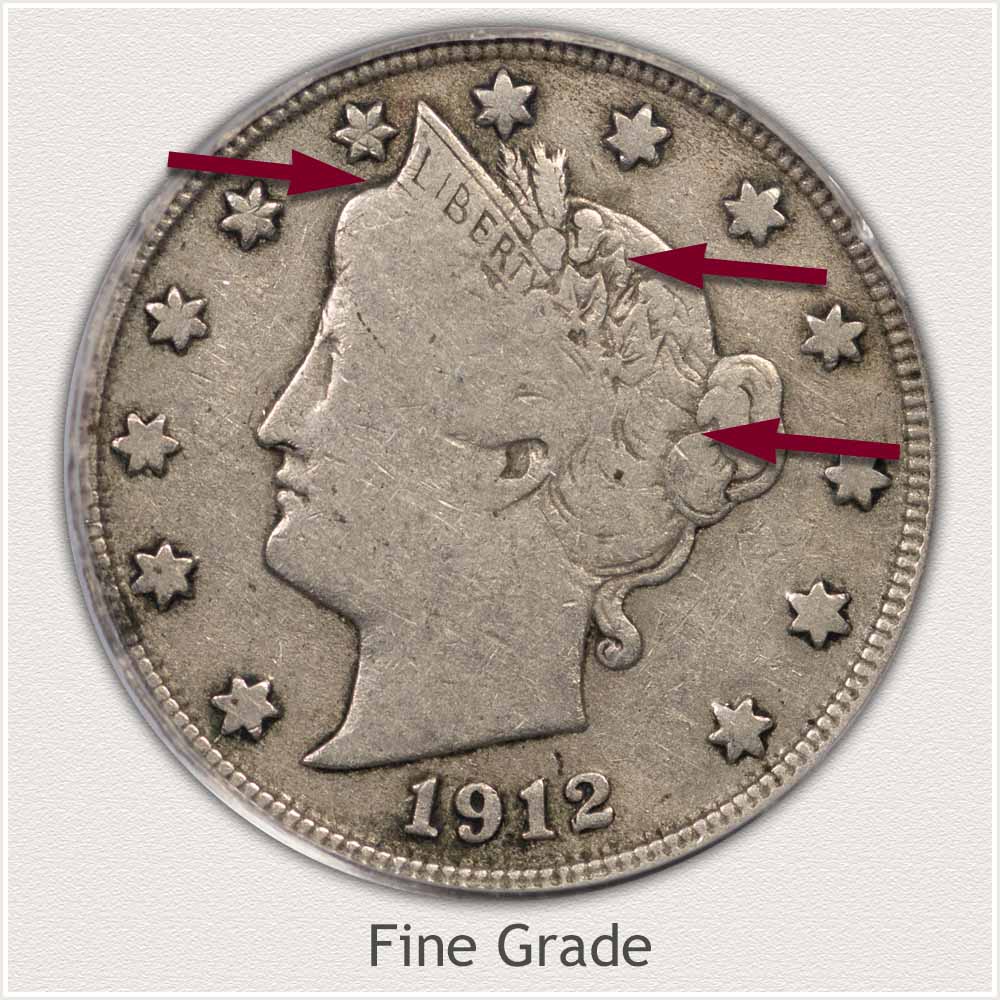
Obverse: Features Identifying the Fine Grade: Heavy wear has now reduced most of the smaller details and created wide areas of flatness.
Important to reaching the Fine grade is all letters of "Liberty" are visible in the coronet. Liberty's head band is faded towards the end, connecting with hair and cotton detail. The letter "Y" is visible and complete.
Another indication of Fine grade condition is the letter "I" remains visible. Often, because of its high relied this portion of the cornet wears first, leaving the "I" just visible. Clear full lettering is confirming the Fine grade.
Boldness remains in hair lines and lower relief portions of cotton and cotton bolls. Hair lines are strong and mostly separated as they approach the tie of hair at back.

Reverse: Features Identifying the Fine Grade: Details of the wreath are beginning to fade and merge together, placing a Liberty nickel in Fine grade.
Details in the centers of cotton leaves have worn smooth creating a flat appearance to the leaf. Once raised leaf edges are now flat and merging with the stems.
Cotton bolls have lost the defining line from the top fluff and bottom portion.
A clear motto "In God We Trust" remains, necessary to achieve a Fine grade and value.
Good Grade: Liberty Nickel
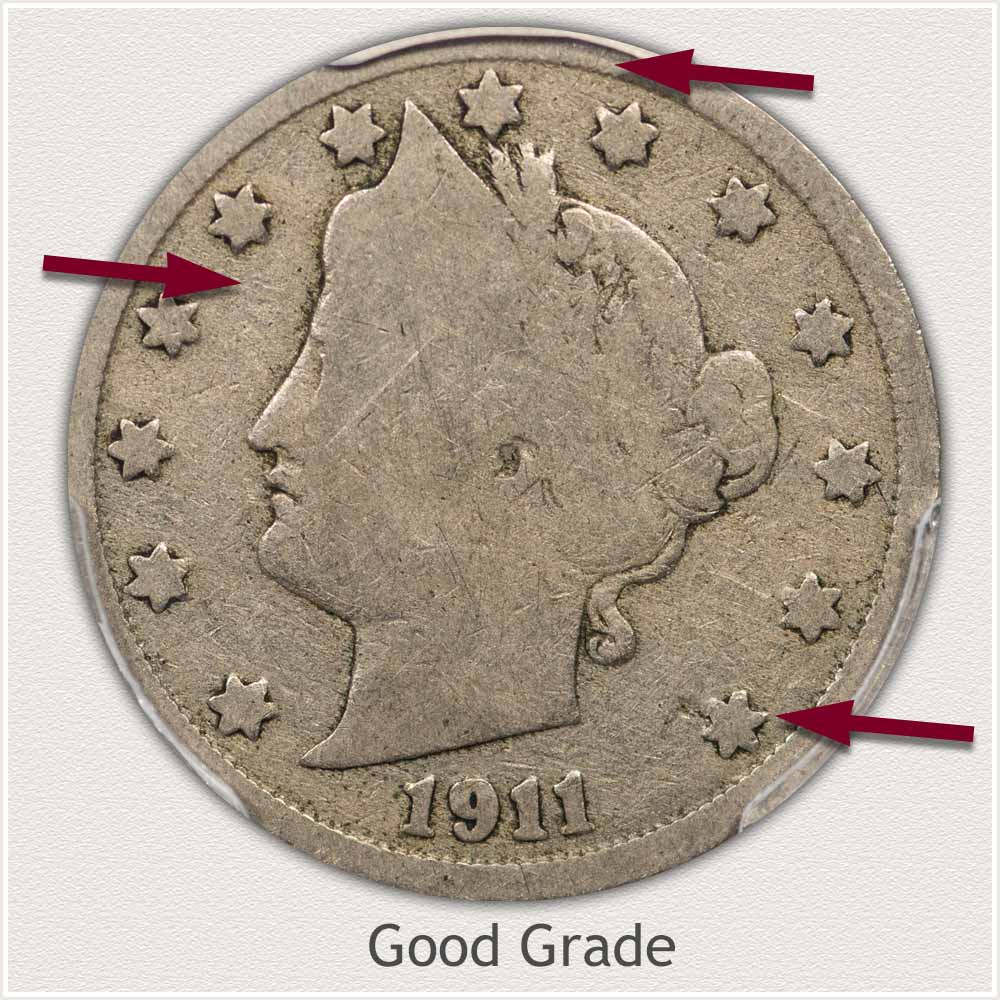
Obverse: Features Identifying the Good Grade: Heavy wear reducing all design elements to flat outlines is a definition of the Good grade.
Liberty's portrait must remain completely outlined with no faded areas connecting to the field of the coin.
Stars are all bold from the field with full outlines. Centers of stars are flat but each star is raised with all points showing.
A complete rim with no blending with the field places this coin solid within the Good grade.

Reverse: Features Identifying the Good Grade: Many parts of the design are faded, with a few areas completely smooth.
Legend along the rim is weak in spots and trying to blend with the rim. Areas of letters are bolder than others due to variance in strike.
Often the motto "E Pluribus Unum" is very weak to missing. Any indications of the motto showing helps with eye appeal and collectability.
Most parts of the wreath are in outline form; a few areas are faint.
A partial to full rim must remain to keep a Liberty nickel in the Good grade range.
How to Video: Grading Liberty Nickels
Set up a single light source and use a magnifying glass to "see" into the subtle details defining each grade. A few moments comparing to a standard grade image and your coin is noticeably within the grade or noticeably higher or lower. Assign each of your coins an opinion of grade.
Grading Liberty Nickels Video and Descriptions
Grading a coin is not an exact science. You form an opinion of a coin's grade, a dealer's and collector's opinion often vary.
Collectors and dealer consider PCGS and NGC as leaders in coin grading services. They both authenticate and grade your coin. The small fee you pay provides assurance you understand and receive the full value of your coin.
Step 3: | Special Qualities Strengthen Value
True collector quality Liberty nickels are found in all grades. Collectors assemble sets in a wide range of grades and values. Affordable to beginning collectors are examples in Good to Fine grades. Higher value and condition coins are sought by more seasoned collectors as they improve on their set of nickels. In any grade, once the condition is judge, next is how nice the coin appears. Certain conditions determining desirability are very noticeable and others subtle.
Recognizing Aesthetic Appeal of Liberty Nickels
Appealing Natural Color

Quickly eliminated as collector quality is the dark toned example. Amount of wear to the surface of the darkened coin would place it in Fine grade. However, highly visible discoloration lowers appeal to all collectors, new to advanced. All collectors choose the natural surface coin.
Minimum Collector Condition

Looking at the two examples, one falls out of collector range in a subtle way. The Low-Quality coin shows the reverse is worn to the point; parts of the design are missing. The Good-Grade quality reverse is just slightly better, with a complete rim and letters and is an acceptable choice for a circulated collection.
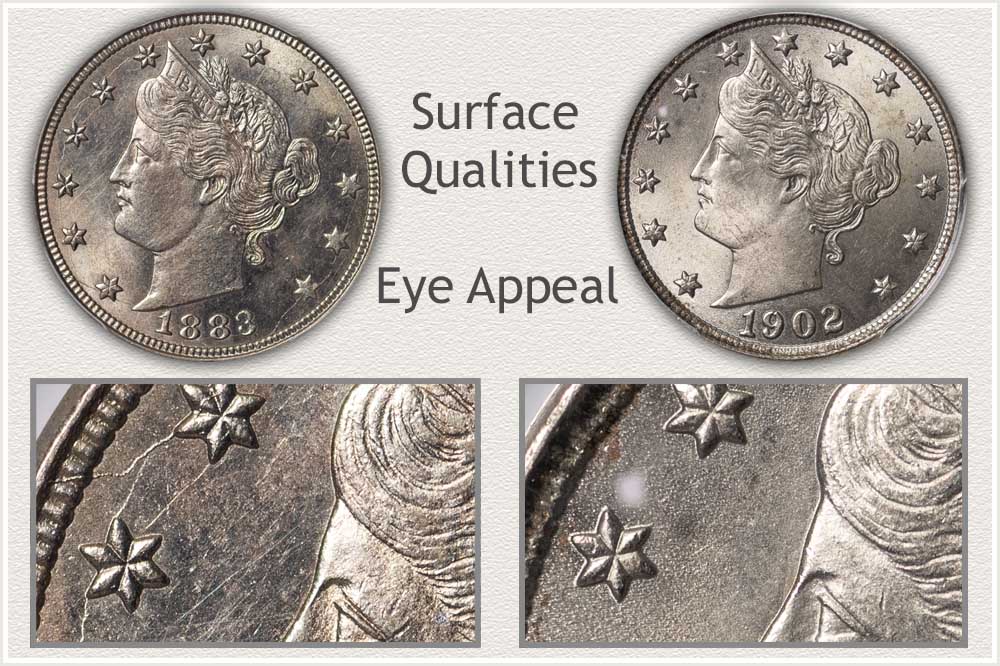
High condition coins are inspected closely for quality. Both coins imaged are mint state, no wear to the surface, a high collectible grade. One example shows a coin struck with an obverse die that has developed cracked areas. Along the surface of the coin these die cracks show as raised lines running through the stars. In one place the crack in the die was deep enough to appear on the raised portion of the star.
In contrast, the coin struck with a sound condition die produced a high-quality strike. In the top Mint State grades, these small details are considered by collectors.
Any coin without distractions is always the strongest market acceptable coin.
References
US Mint. 1883 US Mint Annual Report.
https://nnp.wustl.edu/library/book/311
US Mint. Catalogue of Coins of the United States.
https://nnp.wustl.edu/library/book/554591
US Mint. 1912 US Mint Annual Report.
https://nnp.wustl.edu/library/book/324
US Mint. 1906 US Mint Annual Report.
https://nnp.wustl.edu/library/book/514122
Coin Values | CoinStudy Articles
Date by Date
In Depth Liberty Nickel Values
1883 to 1912
The Value of V Nickels - Today and Tomorrow
Value of V nickels are affordable. The fact they haven't been minted since 1912 and today's current wave of design changes. All if this combined is bound to create renewed interest in this obsolete series. Sparking demand from seasoned and new collectors. Rising values are always the result.
Old Coin Values Using a Step by Step Method
A step by step method is used to discover old coin values. Beginning with identifying important dates and mintmarks. Next comparing your coin to images to judge and determine its condition and recognize its "grade". Value charts narrow how much coins are worth.
Stay current with coin values, return here whenever curious of the value of V nickels.
The index page for the Shield, Liberty, Buffalo, Jefferson and Three Cent Nickels. Find the rare nickels in your box of old coins by matching your coins to the grading images and value charts.
Grading Liberty Nickels How to Video | Images | Descriptions
Visit the in-depth Liberty nickel grading video, combined with enlarged images and detailed descriptions. Dates of your coins are only part of nickel value. Follow the steps to grading condition and it leads to how much your coins are worth, accurately.
Understanding value of your Liberty nickel is a great first step to successfully selling these coins. Resources helping find markets is the next step.
Do you have other denominations?
★Coin Values Discovery... finds the Value of V Nickels and...
All old US coin values. It is an excellent index with images and text links to all coin series, from Cents to Gold. Value charts, grading images and descriptions uncover how much your box of old coins is worth.
